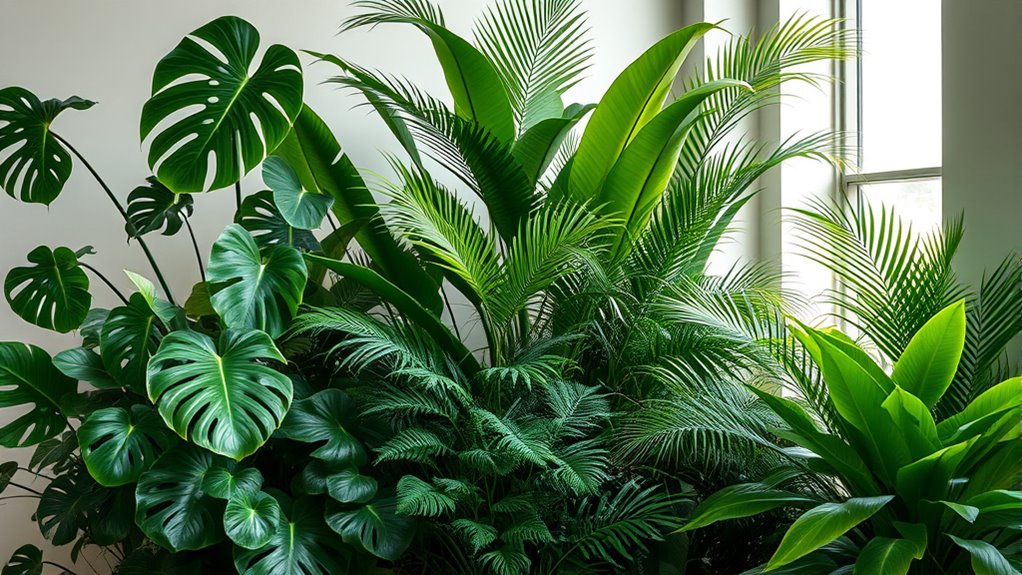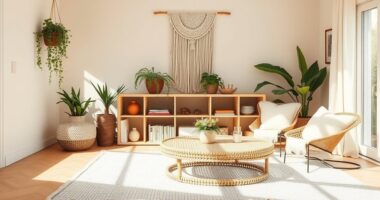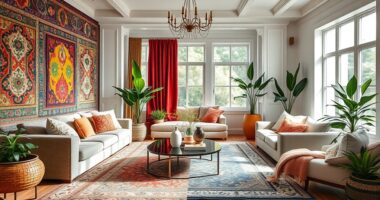To curate a plant jungle without overcrowding, carefully select plants suited to your space and lighting conditions. Use vertical areas with wall-mounted planters and shelves to maximize space. Group plants with similar watering needs and monitor soil moisture to prevent over- or under-watering. Regular pruning keeps plants healthy and neat, while giving mature, spreading plants room to grow prevents overcrowding. With thoughtful arrangement and ongoing care, you’ll create a vibrant, balanced environment that promotes plant health. Keep exploring for more tips on perfecting your jungle.
Key Takeaways
- Group plants with similar light and water needs to streamline care and prevent overcrowding.
- Utilize vertical space with wall-mounted planters and shelves to maximize area without clutter.
- Choose plants with varying mature sizes and growth habits for balanced, harmonious arrangements.
- Regularly prune and repot plants to control growth and maintain a neat, healthy environment.
- Plan placements to ensure each plant receives appropriate light and space to thrive.

Creating a plant jungle isn’t just about filling a space with greenery; it’s about curating a vibrant, balanced ecosystem that enhances your environment. When you start adding multiple plants, it’s easy to fall into the trap of overcrowding, which can lead to poor growth and stressed plants. To avoid this, you need to think carefully about how to arrange your plants so they thrive without making your space feel cluttered. One of the most important factors is understanding your indoor lighting. Different plants require varying levels of light, so you should position high-light plants near windows that get direct sunlight and place shade-loving varieties further away from harsh rays. Making sure each plant gets the right amount of indoor lighting prevents overcrowding regarding space and health, as healthy plants grow better and don’t need frequent rearrangement.
Another key element is establishing effective watering schedules. Overwatering can lead to root rot and other issues, while underwatering causes plants to wilt and struggle. When you’re curating your jungle, consider each plant’s specific watering needs and create a schedule that accommodates them. Group plants with similar watering requirements together, which not only simplifies your routine but also minimizes the risk of neglect or overwatering. Regularly check soil moisture levels to determine if a plant needs water, rather than sticking to a fixed timetable. This mindful approach helps prevent the need to cram in more plants to hide signs of distress caused by improper watering. Incorporating self-watering plant pots into your setup can also help maintain consistent moisture levels with less effort.
As you add more greenery, think vertically and horizontally. Use wall-mounted planters or shelves to maximize space without crowding surfaces. Grouping plants in clusters creates visual interest and allows you to control their growth by pruning and spacing appropriately. When choosing plants, consider their mature size and growth habits to avoid overcrowding later. If a plant is likely to grow large or spread quickly, give it room to breathe from the start. Regular pruning encourages healthy growth and keeps your jungle looking neat rather than chaotic.
Ultimately, a successful plant jungle balances aesthetic appeal with plant health. By paying close attention to indoor lighting and watering schedules, you ensure your plants stay healthy and vibrant. You’ll find that a well-curated space feels lively and lush without feeling crowded or overwhelming. Remember, curating isn’t just about filling space; it’s about creating a thriving, harmonious environment where every plant has room to flourish.
Frequently Asked Questions
How Can I Create Visual Balance in a Dense Plant Jungle?
To create visual balance in your dense plant jungle, start by thoughtfully grouping plants based on size and shape. Use plant grouping to highlight focal points, and incorporate color coordination by pairing plants with complementary or contrasting hues. Balance tall, leafy plants with smaller, bushier ones, and spread out different textures evenly. This approach guides the eye naturally and makes your jungle look lush yet harmonious, without feeling overcrowded.
What Are the Best Lighting Solutions for Diverse Plant Species?
They say, “A little light goes a long way.” For diverse plant species, you’ll want versatile grow light options like LED or full-spectrum bulbs that mimic natural sunlight solutions. These provide consistent, adjustable light levels suited for different plants’ needs. Pair them with natural sunlight when possible, placing plants near windows or using reflective surfaces to maximize light. This approach guarantees healthy growth without overcrowding your plant jungle.
How Do I Maintain Airflow Without Sacrificing Aesthetics?
To maintain airflow without sacrificing aesthetics, you should focus on improving air circulation and humidity control. Use decorative fans or subtle vents that blend into your space’s design, ensuring fresh air moves freely around your plants. Incorporate tall plants or open shelving to promote natural airflow. Additionally, use a humidifier with adjustable settings to keep humidity levels consistent, supporting healthy plants while preserving your aesthetic.
What Are Common Pest Issues in a Crowded Plant Collection?
In a crowded plant collection, pest issues like aphids, spider mites, and mealybugs are common. To combat these, you should practice companion planting with pest-resistant varieties, which naturally deter pests. Regularly inspect plants for early signs of infestation and maintain good airflow to reduce humidity. Using natural predators like ladybugs can also help. These strategies keep pests at bay while maintaining a lush, healthy display.
How Can I Incorporate Different Plant Heights Effectively?
Imagine a lush garden where each plant’s height creates a natural rhythm. You can achieve this by emphasizing plant height variation and vertical layering, placing taller plants at the back or center and shorter ones in front. Use staggered heights and tiered shelves to add depth. This technique guides the eye smoothly and prevents overcrowding, giving your collection a balanced, dynamic look that feels lively yet organized.
Conclusion
Remember, creating a lush plant jungle doesn’t mean filling every space. It’s about thoughtfully choosing and arranging your plants so they breathe and grow freely. Don’t worry about having fewer plants; quality and placement matter more. With patience and care, your greenery will flourish without feeling overcrowded. A well-curated jungle enriches your space and calms your mind—so trust your instincts, and let your garden breathe. Your perfect plant paradise is just a thoughtful touch away.










